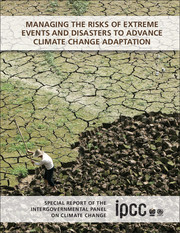 Managing the Risks of Extreme Events and Disasters to Advance Climate Change Adaptation
Managing the Risks of Extreme Events and Disasters to Advance Climate Change Adaptation Book contents
- Frontmatter
- Contents
- Section I
- Section II
- Section III
- Chapter 1 Climate Change: New Dimensions in Disaster Risk, Exposure, Vulnerability, and Resilience
- Chapter 2 Determinants of Risk: Exposure and Vulnerability
- Chapter 3 Changes in Climate Extremes and their Impacts on the Natural Physical Environment
- Chapter 4 Changes in Impacts of Climate Extremes: Human Systems and Ecosystems
- Chapter 5 Managing the Risks from Climate Extremes at the Local Level
- Chapter 6 National Systems for Managing the Risks from Climate Extremes and Disasters
- Chapter 7 Managing the Risks: International Level and Integration across Scales
- Chapter 8 Toward a Sustainable and Resilient Future
- Chapter 9 Case Studies
- Section IV
- Index
- References
Chapter 7 - Managing the Risks: International Level and Integration across Scales
from Section III
Published online by Cambridge University Press: 05 August 2012
- Frontmatter
- Contents
- Section I
- Section II
- Section III
- Chapter 1 Climate Change: New Dimensions in Disaster Risk, Exposure, Vulnerability, and Resilience
- Chapter 2 Determinants of Risk: Exposure and Vulnerability
- Chapter 3 Changes in Climate Extremes and their Impacts on the Natural Physical Environment
- Chapter 4 Changes in Impacts of Climate Extremes: Human Systems and Ecosystems
- Chapter 5 Managing the Risks from Climate Extremes at the Local Level
- Chapter 6 National Systems for Managing the Risks from Climate Extremes and Disasters
- Chapter 7 Managing the Risks: International Level and Integration across Scales
- Chapter 8 Toward a Sustainable and Resilient Future
- Chapter 9 Case Studies
- Section IV
- Index
- References
Summary
Executive Summary
Increasing global interconnectivity, population, and economic growth, and the mutual interdependence of economic and ecological systems, can serve both to reduce vulnerability and to amplify disaster risks (high confidence). Global development pathways are becoming a more important factor in the management of vulnerability and disaster risk. [7.2.1]
The international community has accumulated substantial experience in providing help for disasters and risk management in the context of localized and short-term events associated with climate variability and extremes. Experience in disaster risk management includes both bottom-up and top-down approaches, but most often has developed from disasters considered first as local issues, then at the national level, and only at the international level where needs exceed national capacity, especially in terms of humanitarian assistance and capacity building. [7.2.4]
There are two main mechanisms at the international level that are purpose-built and dedicated to disaster risk management and climate change adaptation. These are the United Nations International Strategy for Disaster Reduction (UNISDR) and the United Nations Framework Convention on Climate Change (UNFCCC), in particular in its adaptation components. This chapter focuses on these two bodies while recognizing that there are many others that have an international role to play. Page limitations require a selective approach and a comprehensive assessment of all relevant bodies is impractical. The UNISDR and the UNFCCC are very different institutions with different mandates and scope and objectives, and with varying strengths and capacities (high confidence).
- Type
- Chapter
- Information
- Managing the Risks of Extreme Events and Disasters to Advance Climate Change AdaptationSpecial Report of the Intergovernmental Panel on Climate Change, pp. 393 - 436Publisher: Cambridge University PressPrint publication year: 2012
References
- 2
- Cited by
